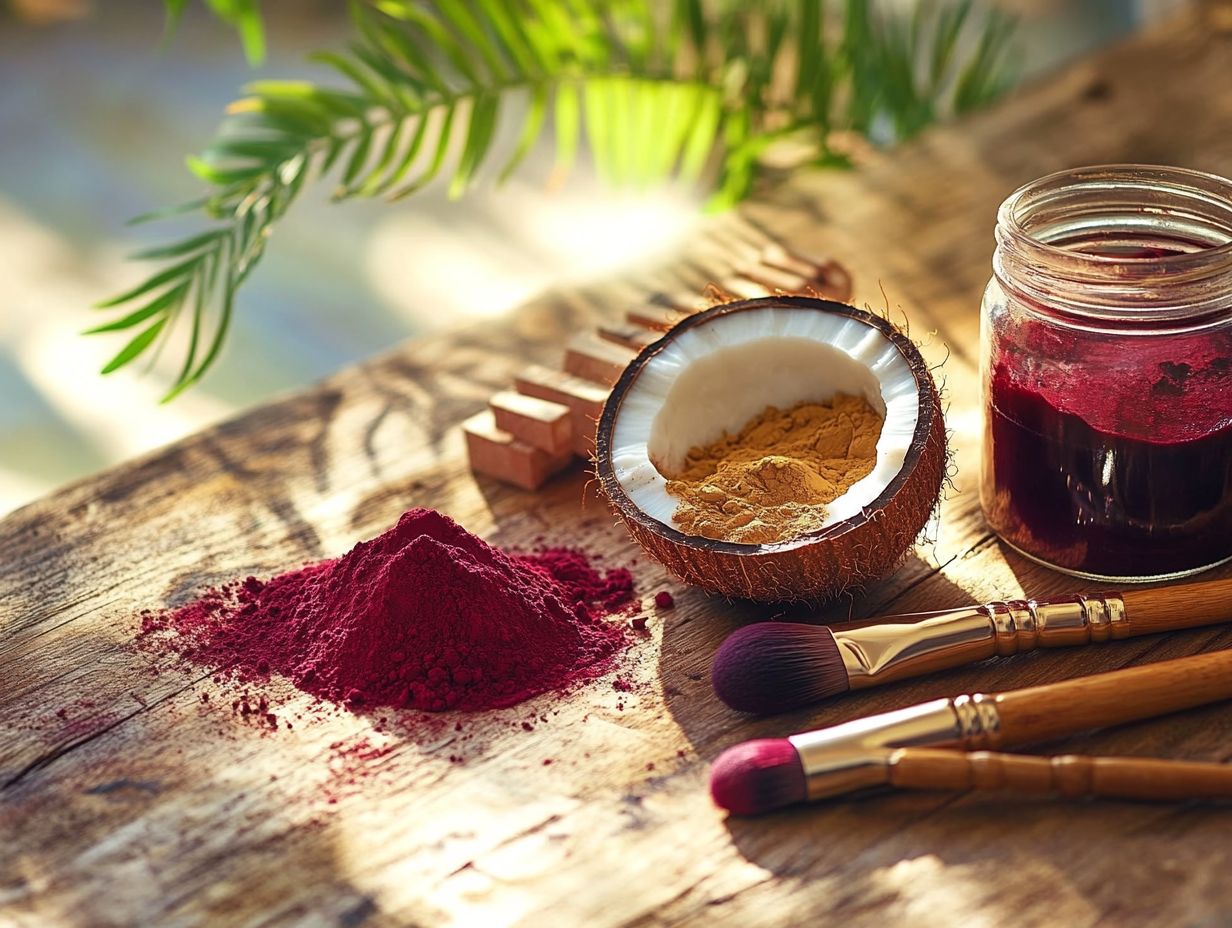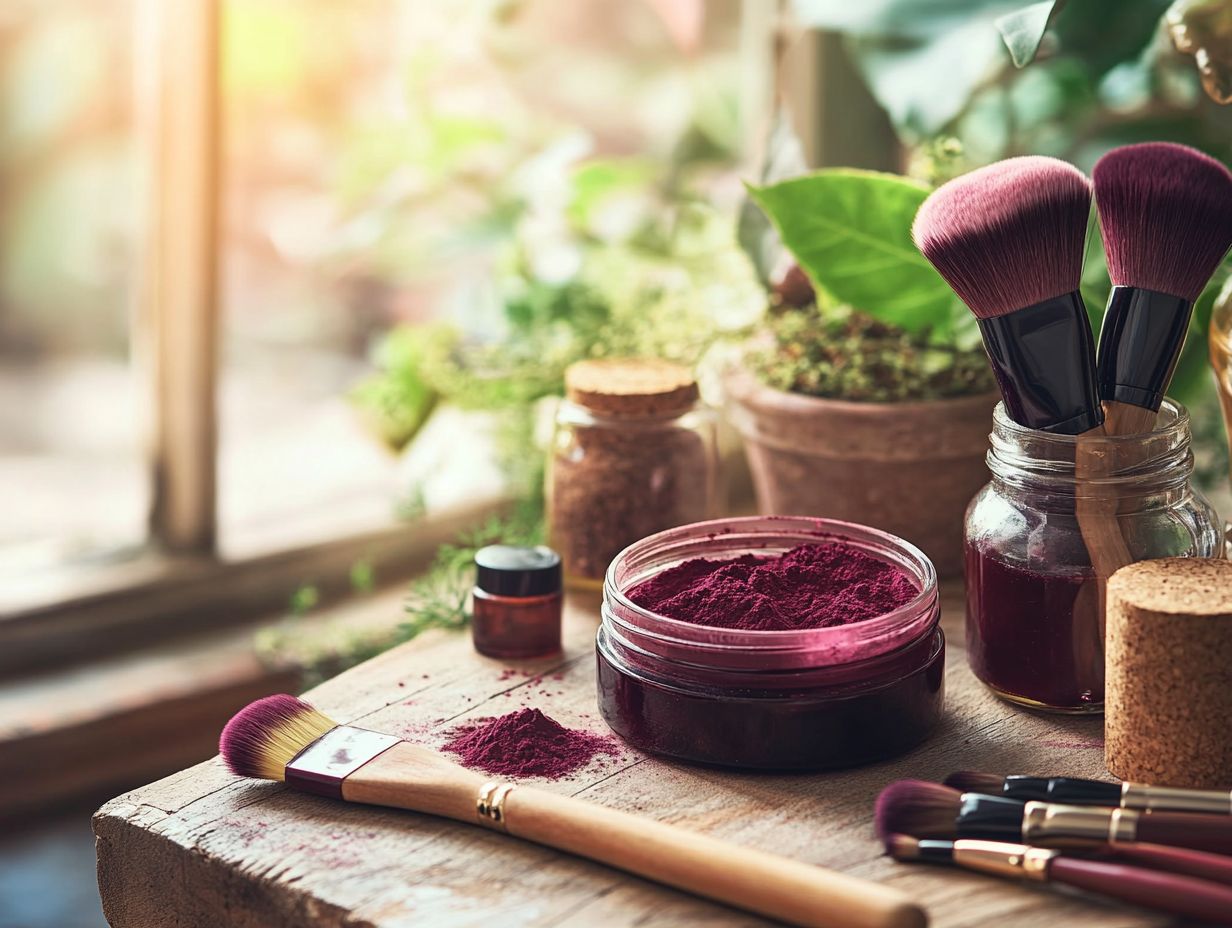Creating your own makeup has never been easier or more rewarding.
Embracing DIY organic makeup allows you to tailor products to your unique skin needs and empowers you to use natural ingredients free from harmful chemicals.
Discover essential ingredients and their beneficial properties, along with easy, step-by-step recipes for making everything from foundation to eyeshadow.
Dive into a world of customization and health-conscious beauty—your skin will thank you!
Key Takeaways:

- Save money and reduce exposure to harmful chemicals by making your own organic makeup.
- Essential ingredients like coconut oil and shea butter provide moisturizing and healing properties.
- Create a customized makeup collection with DIY recipes for foundation, lipstick, mascara, and eyeshadow using natural ingredients.
Benefits of Making Your Own Makeup
Creating homemade makeup presents a variety of advantages that align with the principles of clean beauty and sustainable cosmetics. By choosing to make your own makeup, you gain control over the ingredients applied to your skin, ensuring the use of natural and organic components. This method not only decreases exposure to harmful synthetic chemicals commonly found in commercial products but also facilitates the development of customized solutions tailored to individual skin needs.
Engaging in DIY beauty practices fosters creativity while promoting eco-friendly habits beneficial to both the individual and the environment.
Furthermore, DIY makeup can be surprisingly cost-effective, enabling enthusiasts to save money over time by utilizing pantry staples or readily available ingredients. Personalizing formulas allows individuals to address their unique skin types—whether oily, dry, or sensitive—thereby enhancing their skincare routines. It is also crucial to emphasize the importance of patch testing new formulations to prevent adverse reactions.
By opting to create eco-friendly makeup, individuals can consciously minimize waste and reduce their carbon footprint, contributing to a healthier planet while enjoying the benefits of products aligned with their values.
Essential Ingredients for Organic Makeup
To develop effective and safe organic makeup, it is essential to incorporate key ingredients that are both natural and sustainable, thereby ensuring a clean beauty regimen.
Ingredients such as arrowroot powder, mica powder, and activated charcoal can serve as effective bases for a variety of cosmetic products, offering not only color but also beneficial properties for the skin.
By prioritizing vegan alternatives, one can formulate a range of products that adhere to both ethical and environmental standards, resulting in a healthier and more responsible beauty routine.
Common Natural Ingredients and their Properties

Utilizing common natural ingredients in DIY beauty products can significantly enhance their effectiveness while also ensuring they remain gentle on the skin.
Exploring the extensive range of natural elements can yield numerous benefits for the skin. For example, honey serves as a natural humectant that draws moisture into the skin, and it possesses antibacterial properties that can assist in combating acne.
Similarly, aloe vera is well-regarded for its soothing attributes, making it an exemplary base for sunburn relief or as a moisturizer for sensitive skin.
When incorporating these ingredients into a skincare regimen, it is essential to conduct patch testing to ascertain compatibility. This precautionary measure helps to prevent adverse reactions, enabling individuals to safely enjoy the nourishing effects.
By understanding the unique properties of each ingredient, one can formulate products that address specific skin needs while adopting a holistic approach to beauty.
DIY Foundation Recipes
Creating a personalized foundation at home offers the advantage of tailoring makeup to individual skin types while utilizing organic and sustainable ingredients. Recipes that include arrowroot powder as a base facilitate a lightweight finish and provide oil-absorbing properties beneficial for various skin types.
Additionally, by opting for DIY foundation, one can avoid the toxic chemicals frequently found in commercial products, thereby supporting a commitment to clean beauty and a more environmentally conscious lifestyle.
Step-by-Step Instructions for Making Different Types of Foundation
Creating your own foundation can be a fulfilling DIY project, and adhering to step-by-step instructions is essential for achieving the desired results. It is advisable to begin by gathering key ingredients such as arrowroot powder, cocoa powder, and zinc oxide to formulate a foundation that aligns with your skin tone.
Each type of foundation, whether powder or cream, can be customized according to individual preferences and specific skin needs, thereby reinforcing a commitment to a sustainable cosmetics philosophy.
Exploring various recipes enables individuals to discover unique formulations tailored to different skin types, including dry, oily, or sensitive skin. For liquid foundations, the inclusion of carrier oils such as jojoba or almond can enhance hydration. Conversely, those who prefer cream formulations may find that incorporating shea butter contributes to a smoother finish.
It is crucial to conduct patch tests prior to fully integrating any new ingredient to ensure compatibility with your skin. This practice helps in creating a personalized skincare routine that promotes both comfort and effectiveness.
As each recipe is developed, the satisfaction derived from crafting a foundation that genuinely reflects one’s personal aesthetic cannot be overstated.
DIY Lipstick Recipes

Creating your own DIY lipstick provides the advantage of complete customization in both color and texture, while ensuring the use of organic ingredients free from harmful additives.
Elderberry lip gloss presents an appealing choice due to its natural tint and beneficial properties for the skin. Additionally, a combination of beeswax and coconut oil can deliver both moisture and longevity.
By mastering appropriate proportions and techniques, individuals can produce a range of lip products that not only align with their personal style but also adhere to clean beauty principles.
Simple and Natural Lipstick Recipes
Simple and natural lipstick recipes can be easily executed at home, turning the process into an enjoyable and rewarding DIY project. Ingredients such as beet root powder, which provides color, along with coconut oil and beeswax for moisture and consistency, create a nourishing lipstick that adheres to clean beauty standards. By experimenting with various ratios and additional oils, one can develop a diverse range of shades and finishes while remaining committed to sustainable cosmetics.
This hands-on approach give the power tos individuals to customize their beauty products, ensuring they are fully aware of the ingredients applied to their skin. Utilizing organic ingredients not only enhances health benefits but also reduces environmental impact, reflecting a growing trend towards eco-conscious living.
For example, shea butter can serve as an effective hydrating base, while essential oils like lavender can impart natural fragrance. The incorporation of these elements not only elevates personal aesthetics but also promotes a lifestyle that values purity and sustainability.
Whether one is crafting a bold red or a subtle pink, this creative process nurtures a connection to both nature and self-expression.
DIY Mascara Recipes
Developing a personalized mascara can be a rewarding do-it-yourself endeavor, enabling individuals to circumvent harmful chemicals while attaining the desired volume and definition for their eyelashes.
Charcoal mascara has gained popularity due to its natural coloring and capacity to deliver deep pigmentation without the use of synthetic additives. By incorporating organic ingredients such as shea butter and essential oils, one can create a mascara that not only enhances the appearance of the lashes but also nourishes them, aligning with the principles of clean beauty and environmentally sustainable practices.
How to Make Your Own Mascara with Natural Ingredients

Creating your own mascara using natural ingredients is a straightforward process that enables you to develop a product tailored to your individual preferences and beauty regimen. To begin, combine activated charcoal for pigmentation with shea butter and coconut oil to achieve a creamy texture that applies smoothly to the lashes. This approach allows you to avoid the harsh chemicals commonly found in commercial mascaras while still attaining the desired lift and volume.
Incorporating beeswax can enhance the firmness of the mascara, ensuring it maintains its shape throughout the day. Additionally, almond oil can nourish and condition the lashes, helping to prevent breakage and promote healthy growth.
As you experiment with various proportions, you will discover a formulation that not only enhances your natural beauty but also provides a lightweight and comfortable feel on your eyes. The customization process allows for adjustments in color intensity and application thickness, resulting in a unique product that meets your specific requirements.
DIY Eyeshadow Recipes
Developing your own DIY eyeshadow is an give the power toing approach that enables the customization of your color palette while ensuring the use of all-natural and organic ingredients.
By incorporating mica powder luminizer alongside other natural pigments, it is possible to achieve vibrant shades devoid of harmful additives. This practice not only fosters creativity in makeup applications but also aligns with the principles of clean beauty and sustainable cosmetics, thereby supporting an eco-friendly lifestyle.
Creating Custom Shades with Natural Ingredients
Creating custom shades for DIY eyeshadow provides an opportunity to express individuality while ensuring that all ingredients are organic and safe for the skin. By blending mica powder luminizer with natural pigments such as beetroot or cocoa powder, individuals can craft a diverse range of colors tailored to their preferences. This method not only enhances one’s makeup collection but also aligns with the principles of clean beauty by eliminating synthetic additives.
To initiate this creative process, it is essential to gather the necessary ingredients and tools, including:
- small mixing bowls
- a spatula
- a dropper for any liquid components
When mixing colors, it is advisable to start with a small amount of mica and gradually add the chosen pigments until the desired hue is achieved.
It is important to note that different finishes, such as matte or shimmery, necessitate varying ratios of mica and oils. For a glossy appearance, incorporating a light oil, such as jojoba, is recommended. This not only enhances the color but also provides nourishment to the skin, reflecting the significance of clean beauty in every step.
Before committing to larger batches, always conduct a test of the mixtures on the skin to ensure compatibility and satisfaction.


